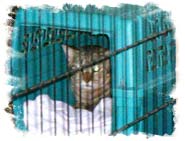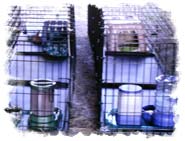 Cats are housed in homes until a barn is located for them. They are kept caged (not happy but safe). The cages are Great Dane-sized with a feeder, waterer, litter box, rug and a hidey box. All the cages are next to or can easily see outside so they feed more comfortable. The hidey box is a small cat-size carrier that is put inside the larger cage. It has a bed or towel in it for the comfort of the cats. The door to the carrier is bungee-corded to the side of the carrier to keep it open. When it is necessary to open the cage for cleaning, the feral cat retreats into the hidey box and we carefully close the door. Now the cat that is in the carrier can be moved out for cage cleaning. When it is time to take the cat to the new barn, again we just close the carrier door, lift it out, and take the cat to the barn site in that same carrier.
Cats are housed in homes until a barn is located for them. They are kept caged (not happy but safe). The cages are Great Dane-sized with a feeder, waterer, litter box, rug and a hidey box. All the cages are next to or can easily see outside so they feed more comfortable. The hidey box is a small cat-size carrier that is put inside the larger cage. It has a bed or towel in it for the comfort of the cats. The door to the carrier is bungee-corded to the side of the carrier to keep it open. When it is necessary to open the cage for cleaning, the feral cat retreats into the hidey box and we carefully close the door. Now the cat that is in the carrier can be moved out for cage cleaning. When it is time to take the cat to the new barn, again we just close the carrier door, lift it out, and take the cat to the barn site in that same carrier.
Barn Cats, Inc. volunteers travel to each barn site, take all the equipment and the cats and set them up in the larger cages for a safe relocation. If a cat comes in with another cat from the same site, we almost ALWAYS put them out together. In most cases they are related…siblings or parents/kids. This seems to make them stay better in their new barn home.

At the barn, volunteers set up a double cage (2’ x 6’) per cats with a feeder, waterer, litter box, and hidey box. If we can put two or three cats together, sometimes we attach three cages together for 2’ x 9’. In the summer, the barn hidey box is the same carrier that the cat has been in while waiting for a barn home. There is a door at each end. ..feeder/waterer at one end and litter box at the other. In the winter, we use a plastic tub with a hole cut in it for a door with a towel, blanket, or bed in it. In the coldest months, two tubs are put over each other for double the protection. One tub keeps the cold out and the other keeps their body heat in. It is always better if two or three cats can go into the same cage because they will perhaps GET IN THAT HIDEY BOX together and have double the body heat. We also encourage the barn owner have a heat lamp or heater if possible. Some barns do not even have electricity so we must be creative by putting bales of hay around the cage. Rugs are included as well in the winter months.
Barn cages are the kind that all come apart with pins in the corner. All the pieces are interchangeable, can be stacked easily, and are not so heavy to move around. All you have to remember is to pack ALL THE VARIOUS PIECES when you are preparing to leave for a barn site. Getting there with NO DOORS can be a problem – you only do that once!
The cats stay in the cages for a two week relocation period. For the release, the barn owner sets up the permanent feeding station, at night closes up the barn (if possible), and leaves the cage doors open. The next morning proceed with business as usual in the barn. The cats have had all night to explore the barn and find their “special” hiding places. They will be on top of the tack room, under pallets, or burrowed into your hay. Feral cats are released at night (nocturnal) and friendlier cats can be released in the daytime.
DO NOT RELEASE IF IT IS RAINING OR THE POTENTIAL FOR RAIN. Cats find their home by scent and rain will wash it away. Waiting one more night will not hurt. Leave the cages set up for an additional week to the cats can come and go if they want. After release, we hope they think of that barn as their new home and decide to stay. Sometimes, they disappear for a week or two but always seem to return to their new home.
